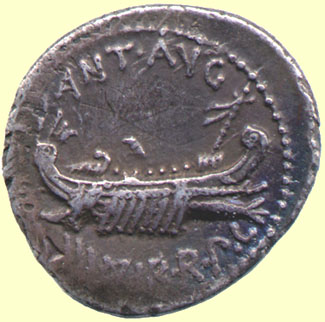 Gallery Thumbs -
Previous Image -
Next Image
Gallery Thumbs -
Previous Image -
Next ImageOften, the lure of collecting coins comes from the idea that the very piece you are holding may have been held by some favorite hero or tragic figure in the past. The collector can hold the coin in his or her hand and look back through the mists of time and stand with that person in the hour of crisis. Most coins that we collect today are capable of being a focal point for our links to the past, and the rest is up to our imagination. That old English hammered penny might have been carried by one of Aethelred the Unready's knights, and just could have been stripped from his dead body by the buff and bloody Danish Viking who had just slain him in the last battle.
There are a few coins, however, about which we can be a lot more certain of circumstances surrounding their issuing and use. These are coins struck for a specific purpose, such as to pay troops for their service or make a payment to a specific foreign ruler. These denarii of Marc Antony's were such an issue, bearing even the number of the legion for whom they were intended. The examples shown here were struck to pay the Eleventh XI Legion and the Twenty - Third XXIII Legion.
Because these coins were struck for such a specific purpose, we can draw several conclusions with a reasonably sure chance that they were true. While nobody has traced any individual coin through any specific person's hands, the following scenarios are highly probable if you are holding a legionary denarius or examining these portrayed here:
Since Cleopatra financed much of Mark Antony's war expenditures, most of the silver in the coin was Egyptian treasure.
As the life of a sailor and that of army troops hasn't changed much over the last couple of thousand years, if your coin is well worn it was probably laid on the counter of many a tavern in Southern Greece or Asia Minor to pay for a pitcher of wine or the embraces of a lady of the evening.
If worn, it probably was present at an ancient naval battle between oared quinquiremes belonging to Antony and Octavian.
If your coin shows little wear, it may have been lost when the paymaster cached away the treasure before his legion went into battle. The legion may have been routed and the paymaster killed. In this case, the secret of where the pay chest was buried would have been lost until an archaeologist or treasure hunter unearthed the coin much later in Medieval or modern times.
Of one thing we can be almost certain. Since the piece you hold in your hands (or see on your screen) was a "coinage of necessity", it has seen plenty of hard fighting and witnessed events leading up to the demise of the Republic. The person carrying it has on more than one occasion either run at top speed toward or away from another dour Roman carrying a short sword and shield and full intentions of skewering him with the former. It knows all about salt water and aching legs and watered vinegar and worn boot nails. It knows about marching twenty miles and building an entire fortified camp for the night and the hope that the general its owner is following remains alive and in power twenty years from now and settles his weary veterans on a nice piece of conquered land where they can build a town and get on with their lives. In short, your coin has been around and seen some things, great and powerful happenings, world shaping events. The chance that your coin has spent its miserable little life inside some merchant's leather bag, losing a few atoms of metal to wear every time that merchant's purse slapped his donkey in the ass while plodding down some rough road to yet another little town in ancient Cappadocia is probably close to nil.
Next Image In Gallery
Previous Image in Gallery
Return to Gallery Thumbs
Coin Glossary